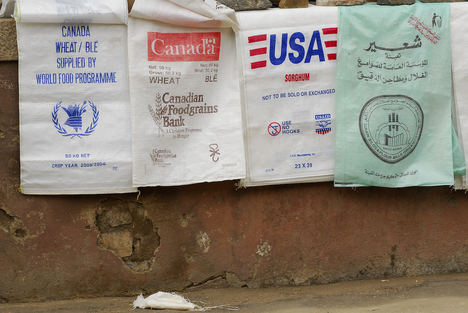
Source: https://www.ugent.be/ps/conflict-ontwikkeling/crg/en/research/projects/humanitarian-aid-and-conflict
The evolution of Canada’s international food assistance policies
The history of international food aid and the impact of changes in food assistance policies since the turn of the century were the focus of the joint Food Systems Research Group and Faculty of Agricultural and Food Sciences seminar by Dr. Ryan Cardwell on October 31.
UNTYING OF INTERNATIONAL FOOD AID HAS INCREASED FOOD AID SHIPMENTS
Canada’s international food aid today looks a lot different than when it began in 1951 as a means to dispose of surplus wheat stocks. In Canada and many other donor countries, both the type of aid and how food is sourced have completely changed during this period.
“When most people think of food aid, they typically think of emergency food aid, which is food donated to recipient countries in response to humanitarian crises, natural disasters, civil conflict, and refugee camps,” explains Cardwell, associate professor in Agribusiness and Agricultural Economics. “Today, the majority of food assistance coming out of Canada is emergency food aid.”
In the past, the majority of food assistance leaving Canada was either targeted to specific initiatives in recipient countries through project food aid, or supplied as a resource transfer providing balance-of-payments support to recipient-country governments through programme food aid. At that time food was primarily sourced within Canadian borders and shipped to recipient countries, referred to as direct-transfer aid.
A shift began early in the 21st century and today the vast majority of assistance is provided in the form of cash, with food being sourced in the recipient country – either locally, regionally or purchased in one country then distributed in another – instead of the donor country providing mainly “home-grown” cereal grains. This shift has allowed for overall greater purchasing power and the ability to provide foods that are more culturally relevant than under the original direct-transfer aid model.
THE MOVE TO UNTYING OF FOOD AID
This shift arose from the untying of food aid. “Tied Aid refers to the requirement that goods and services be procured in the donor country,” says Cardwell. “Untying of aid led to a dramatic shift in international food assistance policies in 2005 and again in 2008 when tying requirements were completely eliminated.”
In 2001, the Organisation for Economic Co-operation and Development (OECD) argued that tying aid makes it inefficient and ineffective for a variety of reasons. Some of the concerns surrounding tied food aid include the cost of processing, shipping, and non-competitive procurement (which raises food-aid prices), the timeliness of shipping (which often took months to be delivered), the negative effects on competing local recipient markets, the possibility of political outcomes being manipulated, and the cultural difference in the food being delivered.
After a lobbying effort that was led by Winnipeg’s Canadian Foodgrains Bank, the Canadian Government reformed its food assistance tying policies in two stages. The tying rate was reduced to 50% in 2005 and was eliminated in 2008. Food aid practitioners (mainly the World Food Programme and Canadian Foodgrains Bank) reacted quickly to this new flexibility in sourcing, and now buy all food assistance outside Canada – usually from markets closer to recipients.
THE IMPACT OF UNTYING FOOD AID
Interested in determining how the untying of food aid affected the quantity of food aid Canada provided, Cardwell, in collaboration with Pascal Ghazalian, associate professor of Economics at the University of Lethbridge, modeled ‘what if?’ scenarios to predict what would have happened if food aid purchases had remained tied to Canadian sources.
Their research shows that untying Canadian-funded food assistance from domestic procurement requirements increased the volume of Canadian cereal food aid. “Policy change has resulted in better outcomes for those in need of emergency food aid,” concludes Cardwell. “And there are likely even further positive effects that were not captured in our modeling.”
Canada and the majority of other donor countries now provide nearly all food aid as cash, although a few countries, most notably the United States – the largest global donor several times over – continues to tie most of its international food aid to domestic sources.
Interested in learning more? The video of this seminar, including the Q & A session is available on YouTube.
FOOD FOR THOUGHT KNOWLEDGE SHARING SERIES
What is the Food Systems Research Group? The FSRG is an umbrella group fostering the creation of multi/trans-disciplinary collaborative research to advance the theme of Safe, Healthy, Just and Sustainable Food Systems.
The FSRG hosts a monthly seminar series featuring UofM research on food systems – joining our mailing list to receive upcoming notifications by sending an email to foodsystems@umanitoba.ca.
Sara Poppel is an economics student in her second year, currently helping with communications with the Food Systems Research Group and the National Centre for Livestock and the Environment.






